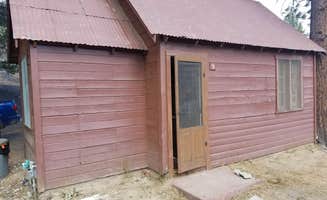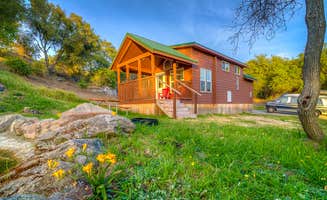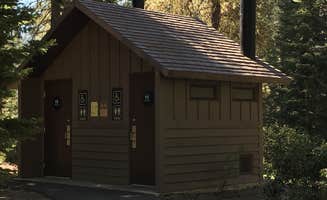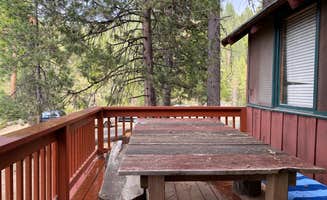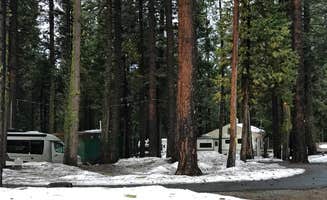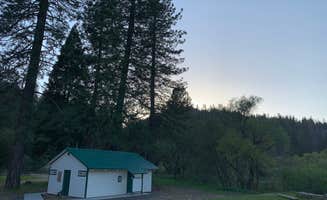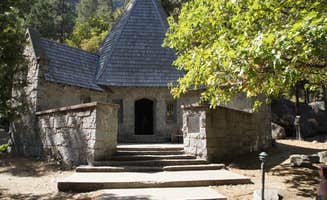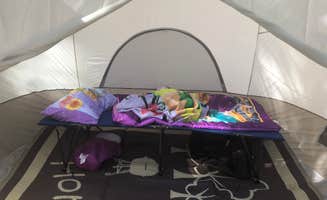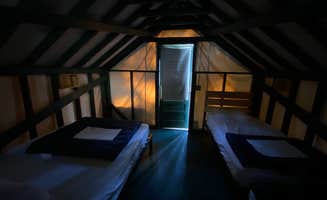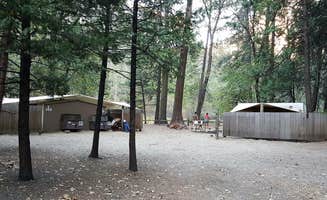Camping near Big Creek, California offers both developed campgrounds and remote wilderness sites at elevations ranging from 3,500 to 9,800 feet. The Sierra National Forest surrounds the area with mixed conifer forests and abundant water features throughout the spring and summer months. Seasonal considerations impact campground availability, with most facilities operating between May and October due to winter snow conditions at higher elevations.
What to do
Fishing in local streams: Dinkey Creek Campground provides access to quality fishing spots. "This camp grounds is clean an well maintained. This is our new favorite place," notes Jeffrey H., who visited with family in 2020. The area offers both lake and stream fishing opportunities with stocked waters.
Explore natural hot springs: At Mono Hot Springs, multiple thermal pools provide varying temperatures. "There are several different pools located across the river from the campgrounds. They are all over the hillside and range in temperature from lukewarm to bath water to Hot," explains Mollie M. Thermal lakes near the springs add additional bathing options.
Waterfall hikes: The region features numerous cascades accessible via short hikes. "The waterfall is a short hike away, and there are plenty of trails to hike during the day, as well as dirt roads to explore," shares Kelli L. about Whisky Falls Campground. Most waterfalls flow strongest in late spring to early summer.
Backcountry trekking: For experienced hikers, trails lead to remote alpine lakes. "We encountered mule train options on our way in if you prefer that type of transportation," mentions Hannah V. about reaching Thousand Island Lake Backcountry, a high-elevation camping area that requires permits.
What campers like
Private sites with creek access: Campers appreciate the secluded nature of certain campgrounds. "We could walk down to the creek from our site, which was nice. There were plenty of small pools for wading and swimming," shares Erin S. about her stay at Dinkey Creek, though she cautions about yellow jackets in late August.
Yurt camping options: While traditional tent camping dominates, yurt camping near Big Creek, California has grown in popularity at certain locations. Several resorts in the region have added seasonal yurt accommodations with sturdy platforms and canvas structures that withstand mountain conditions.
Clean facilities: Many campgrounds maintain good standards despite remote locations. "Bathrooms and camp site was well maintained and clean," reports jerryd about his stay at Deer Creek Campground. Several campgrounds offer flush toilets rather than vault toilets, an uncommon amenity in mountain settings.
Lakeside swimming: Water recreation ranks high among visitor favorites. "The lake is a one minute walk from your site," notes David M. from Deer Creek Campground. "The fishing was amazing!! Everyone with a license caught fish!" Water temperatures remain cool even during summer months.
What you should know
Road conditions: Some campgrounds have challenging access routes. "Kaiser Pass was a bit of an adrenaline rush. It took 2 hours to drive 18 miles on a one lane road that is not in good repair," warns Chris M. about reaching Mono Hot Springs. Four-wheel drive vehicles provide better access to remote sites.
Seasonal closures: Most high-elevation campgrounds operate on limited schedules. Mono Hot Springs operates "from May 25 to October 1" according to its official information, with exact opening dependent on snow conditions. Lower elevation sites like those near Bass Lake often open earlier and close later.
Bear activity: The Sierra Nevada has active black bear populations. "This is active black bear country, so you must use approved bear canisters for food and odoriferous items," advises Dave V. about backcountry camping. Even developed campgrounds require proper food storage; some provide bear boxes.
Permit requirements: Backcountry camping requires advance planning. "Every hiking/camping group must possess a permit, which for a short hike directly into Thousand Island Lake is secured through the Inyo National Forest office," explains Dave V. Quotas limit daily entries to preserve wilderness conditions.
Tips for camping with families
Sites with amenities: For those traveling with children, Camp Edison offers numerous facilities. "Camp Edison has great activities during the summer season including guided educational nature walks, both day and evening, as well as kids' movies in the amphitheater," shares Angela D., who has visited annually for 15 years.
Flat, accessible campsites: When yurt camping near Big Creek, California isn't available, look for tent sites with level ground. "Site 87 had plenty of shade, and we felt relatively isolated," notes Kelly H. about Lupine Campground, making it suitable for families with young children.
Water safety: Lakes and streams provide recreation but require supervision. "Pretty swift for littles," cautions Kate A. about the water at Dinkey Creek. Most natural water features lack lifeguards and have variable depths and currents.
Insect protection: Depending on season and location, bugs can impact comfort. "The only con can be mosquitoes," mentions jesus R. about high country camping. June and July typically have higher mosquito activity, especially near water sources.
Tips from RVers
Site leveling challenges: Several campgrounds have uneven parking pads. "Let me start off by saying there was a fairly big issue with 2 of the 3 spots we reserved. The paved lots were so far from level that we didn't have enough leveling blocks," shares Doug about Dinkey Creek Campground. Bringing extra leveling equipment helps address this common issue.
Limited hookup options: Most Sierra campgrounds offer primitive RV camping. "Full hookups with good water pressure" are available at Bass Lake at Yosemite RV Resort according to Mike H., but this is uncommon in the region. Many campers rely on generators during permitted hours.
Size restrictions: Large rigs face challenges on mountain roads. "Very shady camp sites lots of trees," describes Martha G. about Fish Creek Campground, but tight turns and low branches can damage taller vehicles. Most campgrounds accommodate RVs under 30 feet more easily than larger units.
Dump station availability: Plan waste management carefully. Camp Edison provides both a dump station and portable service options. "There is a dump station on site and also a 'honey wagon' that will come to your site and pump out your waste water, if you desire," notes Angela D. Many smaller campgrounds lack these facilities entirely.



